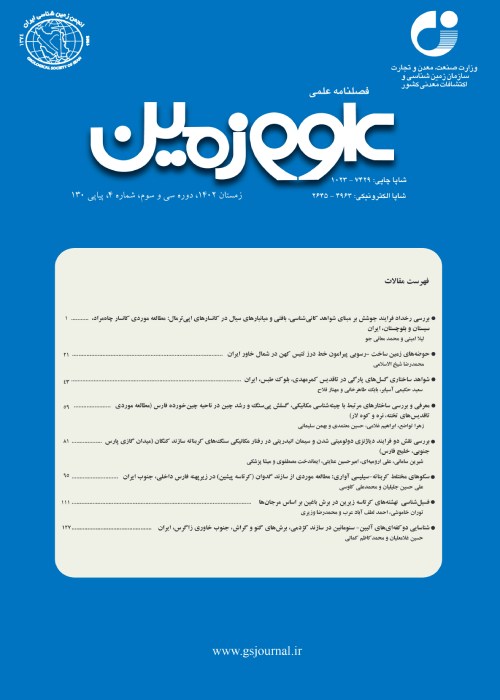Mineralogy of Mahour Zn-Cu-(Pb-Bi-Ag) deposit, west of Dehsalm: implications for genesis and mineralization type
Author(s):
Article Type:
Research/Original Article (دارای رتبه معتبر)
Abstract:
The Mahour Zn-Cu-(Pb-Bi-Ag) deposit located in central Lut Block, formed in an intensely crushed fault zone, dominantly in dacite-rhyodacite volcanic-subvolcanic unit of Late Eocene- Oligocene age. Mineralization occurred as veins, veinlets and breccia massive sulfide and/or as quartz , quartz-carbonate or quartz-muscovite (sericite)- carbonate vein-veinlets. Apart from negligible dark sphalerite, only fine-grained pyrite is observed as disseminated phase within the host rocks. Hypogene mineralization is complex and the main minerals, in order of abundance, are pyrite, Fe-bearing sphalerite and chalcopyrite, with subordinate galena, Cu-sulfosalts, Bi-sulfosalts, Fe-poor sphalerite, and afew greenokite, arsenopyrite, digenite and probably covellite. The Considerable amounts of Ag exist in lattice of some sulfosalt and sulfide minerals, as well as locally negligible Au-bearing W minerals. Mineralization is dominantly associated with sericitic, intermediate argillic and propyllitic alterations and rarely with advanced argillic and quartz- adularia that formed at three main stages including: 1- quartz- pyrite, 2- Fe- bearing sphalerite, and 3- chalcopyrite stage with sulfosalts and minor high sulfidation minerals. Mineralization occurred after silicification and disseminated pyritization that comprise tourmaline (sericitic alteration prior to mineralization) and then weathering process affected it. According to very low dissolution of Cu in Cu-Zn-S equilibrium system, high density of chalcopyrite inclusions in Fe-bearing dark sphalerites in Mahour reveals replacement origin of chalcopyrite disease texture. This texture and mineralogy (ore and alteration) indicate formation of Mahour polymetal mineralization at temperature range of 200-400°C and from an intermediate sulfidation state and low acidity fluid which was neutralized to alkaline by interaction with wall rock. Although, a minor evidence for evolution to high sulfidation state, more acidic and oxidation conditions is recorded in Cu- rich zone. Mineralogical features of the Mahour deposit indicate predominantly magmatic origin for mineralizing hydrothermal fluid, and in combination with mineralization structure, association with calc-alkaline to shoshonitic igneous rocks and tectonic setting of host rocks, are very similar to cordilleran style polymetal lode deposits.
Keywords:
Language:
Persian
Published:
Geosciences Scientific Quarterly Journal, Volume:27 Issue: 105, 2017
Pages:
295 to 308
magiran.com/p1775328
دانلود و مطالعه متن این مقاله با یکی از روشهای زیر امکان پذیر است:
اشتراک شخصی
با عضویت و پرداخت آنلاین حق اشتراک یکساله به مبلغ 1,390,000ريال میتوانید 70 عنوان مطلب دانلود کنید!
اشتراک سازمانی
به کتابخانه دانشگاه یا محل کار خود پیشنهاد کنید تا اشتراک سازمانی این پایگاه را برای دسترسی نامحدود همه کاربران به متن مطالب تهیه نمایند!
توجه!
- حق عضویت دریافتی صرف حمایت از نشریات عضو و نگهداری، تکمیل و توسعه مگیران میشود.
- پرداخت حق اشتراک و دانلود مقالات اجازه بازنشر آن در سایر رسانههای چاپی و دیجیتال را به کاربر نمیدهد.
In order to view content subscription is required
Personal subscription
Subscribe magiran.com for 70 € euros via PayPal and download 70 articles during a year.
Organization subscription
Please contact us to subscribe your university or library for unlimited access!




